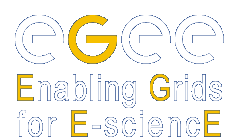Technical Information
ENOC, EGEE Network Operation Centre
- The ENOC in a nutshell
- LCG support
- Linked activities
- Monitoring and troubleshooting
- Further information
The ENOC in a nutshell
The EGEE project relies heavily on using shared resources spanning more than 45 countries and involving more than 1800 production hosts. To link these resources together, EGEE relies on the network infrastructure provided mainly by GEANT2 and NRENs.
NRENs provide link to sites within a country while GEANT2, the seventh generation of pan-European research and education network, connects countries.
To link Grid and network worlds the EGEE Network Operation Centre, ![]() , has been defined in EGEE as the operational interface between the EGEE Grid, GEANT2 and the NRENs to check the end to end connectivity of Grid sites (the schema below does NOT cover the case of LHCOPN - Large Hadron Collider Optical Private Network - or few sites reached over the Internet).
, has been defined in EGEE as the operational interface between the EGEE Grid, GEANT2 and the NRENs to check the end to end connectivity of Grid sites (the schema below does NOT cover the case of LHCOPN - Large Hadron Collider Optical Private Network - or few sites reached over the Internet).

Using daily relations with all providers of the network infrastructures on top of which EGEE is built, ENOC ensures the complex nexus of domains involved to link Grid sites are performing efficiently.

The ENOC deals with network problems troubleshooting, notifications from the NRENs, network Service Level Agreement (SLA) installation and monitoring and network usage reporting. The ENOC acts as the network support unit in the Global Grid User Support (GGUS) of EGEE to provide coordinated user support across Grid and network services.
Higher level interactions with network providers are also foreseen: dissemination of the activities, service enhancements, future deployments, etc. The goal is to ensure the Grid is using networks efficiently and that it takes advantage of latest technologies and services.
The ENOC is currently receiving incident tickets from more than 15 NRENs connecting EGEE sites. At the end of 2007 nearly 80% of certified EGEE sites were covered and automatic impact assessment is more accurate. The aim is to be able to warn the Grid about major network outages impacting it. A dashboard has been included into the CIC portal allowing to report network state to Grid users.
Strong hope and efforts are put into the trouble tickets standardisation task to leverage a formal exchange solution suitable for every entity involved. The ENOC wrote a document on its experience about the trouble ticket exchanges and circulated it among the NRENs through the TNLC representatives. The objective is to foster a standardization format for tickets exchanges. A trouble ticket data model was elaborated and is currently being implemented.


Network monitoring has quickly arisen as a key requirement for the ENOC. A basic tool highlithing connectivity issues was released and has provided very interesting results. Furthermore results are now published to Grid operators through the CIC portal and through the Nagios monitoring prototype for Grid sites.
|
|
|---|---|
|
LCG support
The LCG (LHC Computing Grid) support aims to provide some exchange standard and interoperability regarding other Grid projects supporting the Large Hadron Collider (LHC). For SA2 this is mainly about network monitoring data exchange and communication channels.
The ENOC also is also supporting the LHCOPN (Large Hadron Collider Optical Private Network), the dedicated private network interconnecting CERN and 11 Tier-1 sites across Europe, North America and Asia. This network will carry the multi-gigabits streams of data produced by the LHC experiments.
Current areas of work are helping to design and implement the operational model for this network and L3 monitoring (BGP - with a home-made tool: ASPDrawer) .
|
|
Linked activities
Dealing with a lot of events regarding networks, the ENOC is also investigating the benefits of an ITIL internal use, particularly the ITIL service desk with quality indicators and effective procedures definition.
|
Some tools (DownCollector, etc.) are now released and available through ENOC's web portal. Accesses are granted with any valid Grid certificate. Do not hesitate to contact us if you are a member of the EGEE project and if you do not have one.
The ENOC team is interested in several groups, particularly the ITIL Group, the WLCG monitoring Working Group, LHCOPN's WG, the Technical Management Board- TMB and has close relationships with the SA1 team about Grid operations (User support advisory group - USAG, GGUS, CIC portal, OAT - operation and automation team, etc.).
Monitoring and troubleshooting
For EGEE-III a key task will be to improve the troubleshooting possibilities. As network problems arise daily and impact more and more resources we need to be able to quickly and efficiently detect and follow-up network issues.
Another task will be to assess the Grid sites' network needs.
For theses tasks the perfSONAR framework may be used.
Further Information
For more information about the ENOC you should find documents, studies and reports of interest within the SA2 document repository.
All source code made by the activity is now publicly available within SA2's source code repositories.
Grid users experiencing network problems can efficiently reach us through GGUS setting the problem kind to "Network Problem".
You are welcome to contact the ENOC team using this email address.
Some services provided by the ENOC are available on the ENOC portal. Access is granted with any valid Grid certificate.







